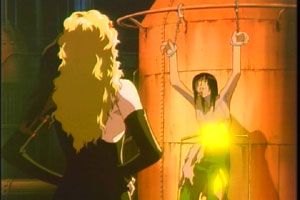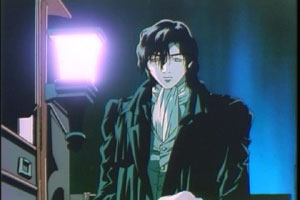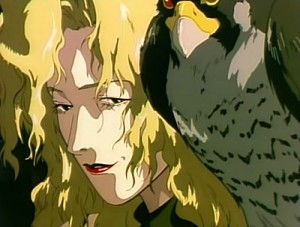Darkside Blues, directed by Yoriyasu Kogawa and Yoshimichi Furukawa. 83 minutes. October 8, 1994.
 Darkside Blues is an adaptation of a s-f story written by Hideyuki Kikuchi, the author of Vampire Hunter D, A Wind Named Amnesia, and Wicked City. More precisely, it is an OAV adaptation of a manga adaptation, or maybe an expansion of Kikuchi’s story, by cartoonist Yuho Ashibe. Comments by knowledgeable reviewers praised Ashibe’s art in the manga.
Darkside Blues is an adaptation of a s-f story written by Hideyuki Kikuchi, the author of Vampire Hunter D, A Wind Named Amnesia, and Wicked City. More precisely, it is an OAV adaptation of a manga adaptation, or maybe an expansion of Kikuchi’s story, by cartoonist Yuho Ashibe. Comments by knowledgeable reviewers praised Ashibe’s art in the manga.
Unfortunately, the OAV adaptation was by J.C. Staff; not the best animation studio. Any beauty or complexity that there may have been in Ashibe’s manga art was not carried into the anime. As for the OAV plot, it’s just confusing. Maybe the OAV presented just a part of Kikuchi’s story, but it looks more like it was never supposed to have a beginning or ending. It seems to basically be an exercise in Atmosphere, dominated by a slow, moody blues-wailing harmonica — music by Kazz Toyama.
Getting behind the deliberately surrealistic beginning, in the future the mega-powerful Persona Century Corporation rules Earth. It has bought 90% of all land surface, and its bureaucrats, armies and police stifle all dissent. The Persona Century Corporation is ruled by the ruthless Hozuki family from a sybaritic orbiting space station, where family patriarch Lando Hozuki allows his decadent children – sadistic blonde Tamaki with her hawk, and effete Guren, the company vice-president – to play at being gods. Other Hozuki children are handsome Enji, a modern god, and Sayo, a reclusive pianist.
 The Persona Century is feebly opposed by both the AP-Men (for anti-Persona Men) guerrillas, and a group of what look like scruffy beatniks called Messiah, led by Mai, living in one of the few areas outside of the PC Corporation’s control; the Shinjuku neighborhood of Tokyo, which has become a slum known as Kabuki-cho, “the dark side of Tokyo”. The Corporation has built skyscrapers all around Kabuki-cho, sealing it off. Separate from all these is a mysterious man described by reviewers as looking like the early 19th-century poet Percy Bysshe Shelley, who may have been accidently created by PC 18 years previously. He apparently lives in another dimension, sees all, and can travel in several places simultaneously, including through the sky, in a horse-drawn coach.
The Persona Century is feebly opposed by both the AP-Men (for anti-Persona Men) guerrillas, and a group of what look like scruffy beatniks called Messiah, led by Mai, living in one of the few areas outside of the PC Corporation’s control; the Shinjuku neighborhood of Tokyo, which has become a slum known as Kabuki-cho, “the dark side of Tokyo”. The Corporation has built skyscrapers all around Kabuki-cho, sealing it off. Separate from all these is a mysterious man described by reviewers as looking like the early 19th-century poet Percy Bysshe Shelley, who may have been accidently created by PC 18 years previously. He apparently lives in another dimension, sees all, and can travel in several places simultaneously, including through the sky, in a horse-drawn coach.
The OAV begins in the mystery man’s extra-dimensional home, where a clock strikes 13 and a spider wraps everything in a scarlet web. The scene jumps to where Tamaki Hozuki is torturing a captured AP-Man guerrilla; a survivor of a terrorist attack on the Hozuki family’s Central Control headquarters. Brother Guren, with a cocktail, comes to watch while she gold-plates the terrorist.
 In Kabuki-cho, Katari, a young boy, looks through a bauble while hanging from a rooftop. He is attacked by a street gang, but he lets go and falls into a black hole that suddenly appears. This is witnessed by Mai and her henchman, Kenzo.
In Kabuki-cho, Katari, a young boy, looks through a bauble while hanging from a rooftop. He is attacked by a street gang, but he lets go and falls into a black hole that suddenly appears. This is witnessed by Mai and her henchman, Kenzo.
The mystery man is observing all this. He goes to all locations in his horse-drawn coach. Tamaki and Guren are displeased by his ignoring of their security. He stops on the street by Mai and Kenzo, When Mai asks who he is, he asks where they are? She says Kabuki-cho, called the dark side of Tokyo. The man takes Darkside as his name. He asks for a place to stay, and Mai directs him to a group of nearby hotels. He chooses the small Hotel Illusion/Mirage, which seems to be run by a grandmotherly woman and her cat.
The next day, as a group of Millennium beatniks lounge around a fountain, an old hippie musician, Mister Delirium, is asked to play a song. He plays “Darkside Blues”, the AP-Men’s revolutionary anthem thirty years ago. A limousine with a military escort appears from PC executive headquarters. A man emerges in futuristic body armor under a business suit, with a cane holding futuristic weapons technology. He announces that there was one escapee from the AP-Man terrorist attack a few days earlier; he is believed to be hiding in Kabuki-cho; and the Corporation is offering a fabulous reward for his exposure or capture.
 Darkside appears and the whole area is plunged into darkness for a moment. The armored PC executive takes this as a challenge. Mai wants to talk to Darkside. He points to his business card that gives the address of Hotel Illusion, 11 Crystal Street, and lists his profession as Dream Treatment.
Darkside appears and the whole area is plunged into darkness for a moment. The armored PC executive takes this as a challenge. Mai wants to talk to Darkside. He points to his business card that gives the address of Hotel Illusion, 11 Crystal Street, and lists his profession as Dream Treatment.
That night(?), Mai and Kenzo are watching the moonrise in a park when the fleeing terrorist, Tatsuya, collapses at their feet. He is followed by a gray gnomelike character from PC who is about to capture him when he pays Mai to save him. She accepts and announces that he is under Millennium’s protection. Mai and the gnome briefly battle — he shows that PC has turned him into a cyborg “monster” – before he leaves in defeat, vowing that PC will return later.
Mai and Kenzo take the gravely-wounded Tatsuya to Selia, the only friend that Mai can trust, for medical treatment. She can’t provide all that’s needed and leaves to get more. The terrorist, Tatsuya, has lost the communicator to call his AP-Man friends, so Mai says that he can remain in hiding in Selia’s apartment for awhile. Meanwhile Darkside at his room in Hotel Illusion renews Katari’s spirit. Mai goes to Hotel Illusion to talk with Darkside.
 Guren Hozuki, in PC’s space station, is informed that his brother Enji has jumped out of an airplane to go slumming in Kabuki-cho. Selia is molested there by a street gang and is rescued by Enji. He escorts her to her destination, Hotel Illusion. She disappears when she enters its doors. The grandmotherly manager explains that Selia went directly to the room that was her goal, while Enji, who didn’t have a goal, has remained in the lobby. Selia’s goal is the room of an alchemist, Pigero, where she gets the Re-Health medicine for Tatsuya. Meanwhile Darkside has been drawn from his room to confront Enji in the lobby. They battle in darkness. Enji concedes defeat but says he’ll be back.
Guren Hozuki, in PC’s space station, is informed that his brother Enji has jumped out of an airplane to go slumming in Kabuki-cho. Selia is molested there by a street gang and is rescued by Enji. He escorts her to her destination, Hotel Illusion. She disappears when she enters its doors. The grandmotherly manager explains that Selia went directly to the room that was her goal, while Enji, who didn’t have a goal, has remained in the lobby. Selia’s goal is the room of an alchemist, Pigero, where she gets the Re-Health medicine for Tatsuya. Meanwhile Darkside has been drawn from his room to confront Enji in the lobby. They battle in darkness. Enji concedes defeat but says he’ll be back.
Darkside apologizes to the grandmotherly manager. She says, “If his target had been anyone but you, Crystal Street might have been reduced to rubble. We were lucky to suffer so little.”
Selia returns to her apartment, where Tatsuya gives his background. PC’s killers with Persona battle robots. Selia and Tetsuya escape into the streets of Kabuki-cho while the PC killers are engulfed by darkness.
This is only halfway through, and I’m tired of writing a detailed plot synopsis. Watch the rest of it for yourselves. SPOILER ALERT: A major character is killed at the end, but other than that, nothing is resolved. The Persona Century Corporation still owns 90% of the world. The AP-Men are still fighting to overthrow it. Kabuki-cho is still run, such as it is, by Millennium, personified by Mai and Kenzo. Darkside, or whatever the mystery man calls himself, is still an Enigma personified.
Do you think the voice actors give a realistic performance? Do you like the jerky animation? Did you notice that the coach horses’ legs move erratically, and that some characters such as Selia deliver long speeches while their mouths don’t move at all? Does the “Darkside Blues” song sound like a good “revolutionary anthem” to you? Do Mai and Guren have a believable backstory?
Darkside Blues was released as a DVD under Central Park Media’s U.S. Manga Corps label on October 26, 1999. It was taken over by A.D. Vision Films on August 18, 2009 after CPM filed for Chapter 7 bankruptcy earlier that April. Today A.D. Vision is gone, too.
Next week: “Forgotten” OAVs #31.


 Fred Patten (1940-2018) was an internationally respected comics and animation historian. He has written about anime or comic books for publications ranging from Animation Magazine and Alter Ego to Starlog. He was a contributor to The Animated Movie Guide (2005), and is author of Watching Anime, Reading Manga (2004, Stone Bridge Press), a collection of his best essays, and Funny Animals and More (2014, Theme Park Press), based upon his early columns here on Cartoon Research. He passed away on November 12th, 2018.
Fred Patten (1940-2018) was an internationally respected comics and animation historian. He has written about anime or comic books for publications ranging from Animation Magazine and Alter Ego to Starlog. He was a contributor to The Animated Movie Guide (2005), and is author of Watching Anime, Reading Manga (2004, Stone Bridge Press), a collection of his best essays, and Funny Animals and More (2014, Theme Park Press), based upon his early columns here on Cartoon Research. He passed away on November 12th, 2018.





































It’s a great example of a mystery and horror anime. Yoriyasu Kogawa was a unit director of Legend of the Millennium Dragon too. What I especially liked about Darkside Blues: the battle in the dark.
Zach Swedberg, Canadian-Indian writer
https://writemyessaysonline.com